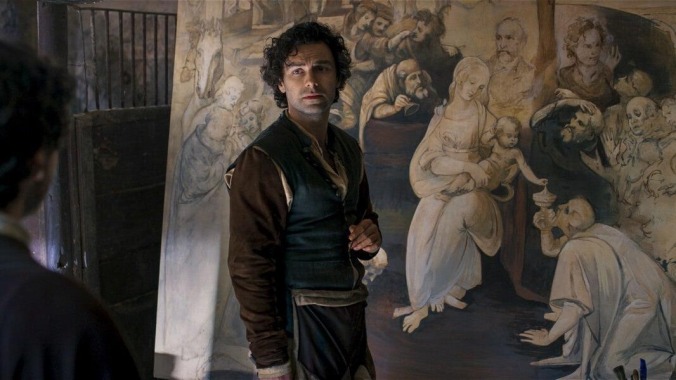Leonardo is a sketchy da Vinci drama
Despite a fine turn by Aidan Turner, the CW's latest stumbles with a contrived murder mystery

Leonardo da Vinci, the type of figure who transcends time and space, has been the subject of endless fascination for centuries. So it’s a shame that Leonardo, the latest CW acquisition to debut in the States, attempts to capture the spirit of the genius behind the Mona Lisa and The Last Supper and non-artistic feats by playing fast and loose with the facts of his life for dramatic effect. Creators Frank Spotnitz and Steve Thompson have concocted a historical drama that not only lacks the oomph of more inventive period pieces on television right now, but they’ve also undermined its protagonists with a contrived murder-mystery subplot.
In his first TV role since the BBC adaptation of Poldark ended in 2019, Aidan Turner stars as the titular polymath who is initially introduced to audiences in two different timelines: first as a bearded, brooding prisoner accused of poisoning his muse, Caterina da Cremona (The Undoing’s Matilda De Angelis), and questioned by officer Stefano Giraldi (The Good Doctor’s Freddie Highmore); and then as a fresh-faced, awkward apprentice at the studio of renowned painter and sculptor Andrea del Verrochio (Giancarlo Giannini) in Florence, some 16 years earlier.
Giraldi’s investigation of Caterina’s death, and Leonardo’s potential involvement, serves as a framework for each of the episodes, which essentially consists of the officer interviewing various people from Leonardo’s inner circle, who all point to his obsessive inquisitiveness and unrelenting pursuit for perfection in his work as his fatal flaws. Despite dialogue that feels a touch too meta and modern for the 15th century (for instance, da Vinci’s left-handedness and vegetarianism are explicitly mentioned instead of just shown onscreen), Turner gives a multilayered portrayal of Leonardo, elevating the series beyond a picturesque tour of Florence and Milan, where his character often goes from feeling uninspired to having tunnel vision. (These are told in multiple sequences meant to evoke the spirit of a genius at work.) To his credit, Turner captures both the intensity of an outsider searching desperately for his father’s approval and the endearing innocence of a young man who has a habit of putting his foot in his mouth.
Highmore, meanwhile, is uncharacteristically monotonous as Giraldi, playing the part of a Milan officer who brings very little to the first four episodes and grows increasingly wary of potentially executing one of the most famous artists of all time. Giraldi, it seems, is not the only one who has reservations about the murder mystery. As a plot device, it simply doesn’t work. There might be a few references to her life on the street, including how she ended up with a scar on her back that Leonardo immediately notices when they first cross paths, but the lack of exposition about Caterina’s past—at least in the episodes we saw—leaves us pretty ambivalent about her inevitable death. As much as De Angelis tries to capture the essence of a forward-looking woman navigating court politics and the social mores of her time, she can only do so much with so little.
Caterina, at the end of the day, might have just been a figment of someone’s imagination. With the exception of Giuseppe Bossi (an Italian art historian) and Charles Nicholl (one of da Vinci’s modern biographers), who both insist that da Vinci had a relationship with a lover named “La Cremona” to potentially help him paint women better, there is little evidence to support Caterina’s real-life existence. In fact, many art scholars agree that da Vinci was likely gay. While his real arrest for sodomy and subsequent acquittal at the age of 24 are dramatized in the series, Leonardo’s homosexuality is largely swept under the rug in favor of his (potentially nonexistent) relationship with Caterina, a dynamic that is curiously codependent and difficult to pin down.
In a crowded TV landscape with daringly innovative takes on the period drama (The Great, Outlander, Bridgerton), Leonardo would have benefited from an earlier and deeper exploration of its titular character’s sexuality, which was arguably tied to some of his greatest works. Instead, the show’s failure and reluctance to dig into da Vinci’s personal life only underscores its shortcomings, making this portrait of the polymath feel more like a safe sketch than a masterpiece.